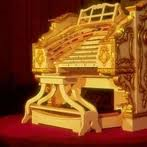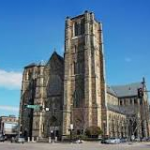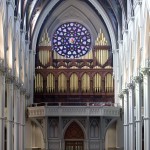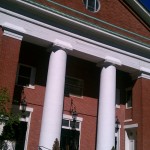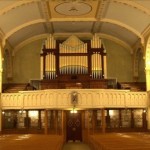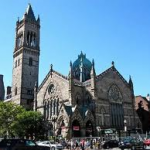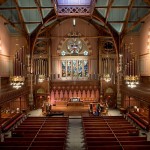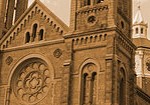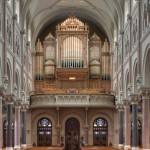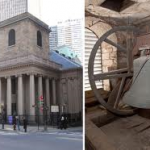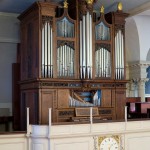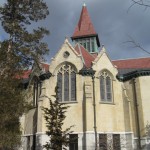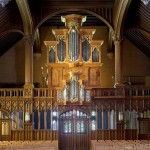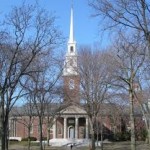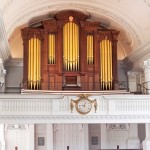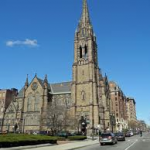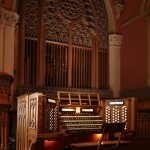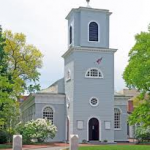Completed in 1999, the Shanklin Music Hall was constructed by industrialist Garrett Shanklin to house a Wurlitzer pipe organ. His intention was to recreate the four-manual, twenty-five-rank instrument installed in the Boston Metropolitan Theatre (now the Wang Theatre) in 1928. Mr. Shanklin acquired pipework, mechanism, and original console toward this end, increasing the size of the original by eight ranks. Crome Organ Company restored and installed the majority of the organ, assisted by Donald Phipps and Allen Miller. Electric Saucer Bells, a thirty-two-foot Bourdon, and a seven-foot Mason & Hamlin Ampico reproducing piano are among the rarities here. The hall hosts numerous public and private concerts each year, and is used regularly by the Eastern Massachusetts Chapter of the American Theatre Organ Society.
Category Archives: Venues
Cathedral of the Holy Cross
At 364 feet long, ninety feet wide, and 120 feet high, with a seating capacity of 1,700, Holy Cross Cathedral is New England’s largest church. Dedicated in December 1875, it was built of locally quarried Roxbury puddingstone and Quincy granite to designs of noted ecclesiastical architect Patrick C. Keely. The advent of cast-iron construction permitted exceptionally slender nave columns supporting the largest wooden vault of its time. An unfashionably remote location—the former site of the town gallows—betrays Anglo-Saxon Protestant Boston’s ambivalence toward waves of “foreign” immigrants, for whom the new cathedral’s completion after nine years of construction was a signal achievement.
The 1875 Hook & Hastings wasn’t the largest organ built in the United States during the nineteenth century, but at seventy voices and 101 ranks it is the biggest to have survived unscathed. Built in the early years after Francis Hastings assumed control of the firm from founding brothers Elias and George Hook, Holy Cross’s instrument was the first of several organs intended to generate considerable power in vast spaces. Fully a quarter of the organ’s resources—twenty-seven ranks—are vested in a blazing Great chorus topped by a Trumpet and Clarion imported from France. With a five-rank cornet in every department, many registers of pure tin, and a ten-inch pressure Tuba built and voiced in the Hook & Hastings shop, here was Hastings’ manifesto on post-Civil War tonal heroism.
Like the neighborhood itself, Opus 801 languished into the twentieth century and into the shadows of newer, “better” organs with electric action and French horns. In the 1920s, the organ was casually electrified and fitted with a second-hand theatre organ console. The Hook revival of the 1960s and ’70s brought renewed attention, however. More recently, under the tireless banner-waving of Cathedral organist Leo Abbott, the instrument is seeing happier days. In 2003, Andover Organ Company supplied a modern console patterned after the original, and in the past decade has undertaken select restoration as funding has become available.
St. Joseph Church
Long before the term “white flight” entered the language, white Bostonians spent an inordinate amount of time fleeing one another. Saint Joseph’s survival bears witness to two tumultuous periods in the city’s history. Built for Congregationalists in 1834 by Alexander Parris, Boston’s leading architect after Charles Bullfinch departed for Washington to complete the U.S. Capitol, the church briefly attracted its intended constituency. By 1862, however, the West End was largely Irish Catholic, prompting a sale to the archdiocese. Successive waves of immigration brought Eastern European Jews, Armenians, Greeks, and Syrians to Boston’s most diverse melting pot. Government authorities in search of a higher tax base declared the solid working-class quarter a slum in 1953, leveling forty-six acres and displacing 2,700 families, few of whom could afford to return to unsightly new high-rises. Happily untouchable as a church, Saint Joseph’s regained its vibrancy to stand as a lonely reminder of a vanished neighborhood.
The 1883 Hook & Hastings is an excellent example of how that company matured into a manufacturing powerhouse while retaining remarkable quality. If the stoplist for Opus 1168 is not exactly typical of two-manuals, with such big-organ luxuries as a Great sixteen foot and three Swell four-foot stops, the tight choruses, polished delicacy, and excellent reeds are. They bear witness to Hook & Hastings’ enviable quality and consistency in this period.
.
Old South Church in Boston
Originally known as New Old South Church (“new” being 1875), to distinguish it from still-standing Old South Meeting House (1729), this is the third home of a congregation gathered in 1669 that has counted Benjamin Franklin, William Dawes, and Samuel Adams among its members. Cummings & Sears adapted John Ruskin’s Venetian Gothic style to a corner lot in a masterful way, evoking hints of Basilica San Marco. In 1905, Louis Comfort Tiffany replaced the original interior stenciling with his own in purple and metallic silver, covering Clayton & Bell’s stained glass with purple glass, as well. That decorative scheme perished under a coat of battleship grey paint in the 1950s, followed by a skillful if muted approximation of the original interior in 1984. As if in sympathy with the collapse of San Marco’s campanile in 1902, Old South’s bell tower began listing by the 1920s and had to be pulled down and rebuilt slightly lower in 1937.
George Hutchings trained in the Hook factory, but when it became clear that Francis Hastings was to assume the reins, Hutchings set out on his own in 1869. His large three-manual in 1875 for the gallery of Old South showed just how quickly he brought his establishment up to speed, for here was an instrument comprehensive in both tone and mechanism, with Barker Levers alongside a free-reed Physharmonica. Behind the same case, Ernest Skinner installed his Opus 231 of 1915, retaining the east-end location for a Solo and thirty-two-foot Bourdon. With three thirty-two-foot voices, and larger than Skinner’s 1913 flagship at New York’s Saint Thomas Church, the Old South instrument was Skinner’s first truly large opus on home turf.
In 1969, ninety-three ranks of Reuter arrived, divided between gallery and chancel with consoles in both locations. The Skinner’s thirty-two-foot Violone and Bombarde were retained, the latter a leaden foundation under the Reuter’s lean, steely sound. The church decided to revert to Skinner after a dozen years, inspired by news that a large 1921 organ, similar in scope to Old South’s 1915 instrument, was about to be demolished along with its home, the Auditorium in Saint Paul, Minnesota. Saved from the wrecking ball, Skinner Opus 308 was brought to Massachusetts. A partnership of Casavant Frères and Hokans-Knapp took charge of the organ’s rebuilding and re-engineering. For the first time, all musical forces would be grouped at the east end with the clergy. Great and Pedal were installed behind the chancel screen, with Swell and Tuba Mirabilis stacked in the south tower, and Choir, Solo, and String in the north. The thirty-two-foot pipes are dotted about the landscape: Violone in the northeast, Bombarde in the southeast, Dulciana (ex-1915 Skinner Violone) in the south tower façade, wood Diapason in the west gallery. Nelson Barden undertook extensive rebuilding and tonal renovation from 1986 to 1990, using vintage Skinner pipework and new material from Austin and Schoenstein. In 1996, Austin supplied all-new Gallery manual pipework. With 115 ranks, this is Boston’s second-largest organ.
Casavant Frères, Ltée and Hokans-Knapp, Associates – 1982-1984, rebuilding and reconfiguration Nelson Barden Associates, Inc. – 1987-1990, rebuilding and tonal changes
The Basilica of Our Lady of Perpetual Help/Mission Church
Properly known as the Basilica and Shrine of Our Lady of Perpetual Help, Mission Church was erected between 1876 and 1878 of locally quarried Roxbury puddingstone and Quincy granite, its 215-foot towers not completed until 1910. Long associated with the Redemptorist Fathers’ missions to the disenfranchised, Mission Church is one of fifty-four minor basilicas in the U.S., entitled to its own coat of arms and a papal umbrellina, kept half-open to signify the Basilica’s readiness to host His Holiness at any moment. Alexandre Guilmant played the organ shortly after its installation.
Robert and Richard Lahaise – 1968, tonal and mechanical changes
King’s Chapel
King’s Chapel opened in 1689 as the first Anglican church in Boston, Peter Harrison’s larger granite building replacing the original wooden structure by 1754. The planned steeple remains a good intention. Firmly loyalist at the American Revolution, defections steadily reduced attendance until March 10, 1776, when Reverend Henry Caner packed up the church silver and headed for Halifax. James Freeman, lay reader at the re-opened church by 1782, embraced Unitarianism with a fervor that prompted the Episcopal bishop to refuse his ordination. Undaunted, pew owners ordained Freeman themselves, establishing the first Unitarian church in America. Prominent King’s Chapel musicians have included William Billings, William Selby, Virgil Thomson, and Daniel Pinkham. A bell cast by Paul Revere still peals out on Sunday mornings. Those accustomed to contemporary patterns of Unitarian-Universalist worship might not recognize the Sunday morning goings-on here, conforming as they do more to Anglican patterns.
The organs of King’s Chapel read like a nutshell history of American organ-building. The first instrument, the famous English-built “Brattle” organ, ended up at King’s after its first parish rejected the instrument on theological grounds. With the new building came a second instrument, in 1756, from London builder Richard Bridge. A century later, in 1860, it was time for a third organ, this time by Simmons & Willcox, who reused much Bridge material. John Henry Willcox favored innovation, best seen here in placing the sixteen-foot chorus reed in the Swell rather than the Great. The fourth organ, from Hook & Hastings in 1884, was a straightforward affair resembling dozens of its contemporaries.
Ernest Skinner’s 1909 instrument swept aside the old, introducing electric action, duplexing, thumb pistons, and orchestral pretensions, all clothed in an elegant Georgian Revival case-front. Aeolian-Skinner made revisions in 1946, a foretaste of the building’s sixth instrument, installed by Charles Fisk in 1963. The first three-manual tracker built in the United States in the twentieth century, it re-used several old ranks and Fisk designed a case that dared to look old but not slavishly so. Undaunted by the absence of any acoustical ambience, Fisk returned later to switch around a few stops and install reeds made in his own shop.
Houghton Chapel, Wellesley College
Wellesley College, an undergraduate liberal arts college for women founded in 1875, lies twelve miles west of Boston on five hundred acres of wooded hills and meadows surrounding Lake Waban. Laid out by Frederick Law Olmsted, Jr. under supervising architect Ralph Adams Cram, the campus is celebrated for its idyllic beauty. A 182-foot tower dominating the academic quadrangle contains a carillon installed by Gillett & Johnston in 1931. Heins & La Farge, authors of the original plan for New York’s Cathedral of Saint John the Divine, designed Houghton Chapel in 1897 in a curiously squat neo-Gothic style. Noteworthy features include sculpture by Daniel Chester French and stained glass by John La Farge, Tiffany Studios, and Charles J. Connick. Next door, the façade of the College’s first music building bears an unmistakable resemblance to the organ case at Methuen Memorial Music Hall, both designed by Hammatt Billings.
George Hutchings installed his Opus 451 here in 1898, a three-manual organ. Its replacement, a sizeable 1936 Aeolian-Skinner, was meant to follow in the wake of G. Donald Harrison’s sweeping statements at Groton School and Church of the Advent, with an orthodox stoplist, low pressures, and concern for mild clarity. Unfortunately, Houghton Chapel lacked not only the unenclosed Positiv but also the good chambers and supportive acoustics of the other two situations, and the instrument never commanded a similar regard. In the 1960s, local builder Conrad Olson extensively re-voiced the manual flue choruses and revised the Swell mixtures.
The Fisk organ in the gallery, that firm’s Opus 72, is the last to have been finish-voiced by Charles Fisk himself. It continues to be among his most fascinating works. Expressly informed by early Dutch instruments, with certain stops modeled after the famous Compenius organ at Frederiksborg Castle, the Wellesley organ took shape slowly, with discussion beginning in 1972, research trips undertaken in 1974 and 1977, and the organ inaugurated in 1981. It was the first major American instrument tuned in meantone, which, coupled to the organ’s key action (with sub-semitones) and wind system (the organ can be foot-pumped), opened a new sound horizon for performing Dutch and German music of the pre-Bach era. The energy and vision of Owen Jander brought about the completion of aspects left prepared in 1981. The Pedal Posaune and carvings were installed in 1983 and the Brustpedalia in 1987, and the case oiled and gilded in 1992.
The Memorial Church, Harvard University
Harvard had a distinct chapel as early as 1744, its location changing regularly until Appleton Chapel settled into the present site in 1858. Though long outgrown, it was not replaced until 1932, when Coolidge, Shepley, Bulfinch & Abbott, successors to H.H. Richardson, erected the present structure as a war memorial. The ponderous columns of the porch announce a prosperous, well-fed neo-Georgian style, a suitable counterweight to the bulk of Widener Library and Richardson’s masterful Sever Hall across the Yard.
Aeolian-Skinner’s Opus 886, designed and finished by G. Donald Harrison, had 120 ranks with seventeen more and a large gallery section prepared for. While meant to be a pace-setter of orthodoxy, with complete flue and reed choruses on all manuals and pedal, its English bent and smothering chambers yielded a tone more Beef Wellington than Dover Sole, not unlike the chaste-in-principle but plump-in-result architecture.
When Charles B. Fisk (Harvard ’49) turned his attention to The Memorial Church, he hoped to install an organ in the gallery. Overruled by no less than Harvard President Nathan Pusey, the new Fisk Opus 46 took root at the head of Appleton Chapel in front of the Palladian window, from where its tone hoped to claw its way past the heavy screen and into the main church. The first four-manual American tracker organ built in the twentieth century, its disposition reflected the conditions at hand: a strong-toned Great and Positive on top, softer Swell and Choir down low for daily use. Opus 46 won over its players perhaps more than audiences, however, and in time came to be seen as compromised as its predecessor.
The two organs now in The Memorial Church reflect lessons from the first two instruments. A recycled 1930 three-manual Skinner, re-engineered and reconditioned by Foley-Baker, Inc., was installed in the chapel chambers; what once contained 120 ranks now have forty-five. This instrument leads daily Morning Prayers (voluntary, hymn, choral selection) and is occasionally heard in recital. The 2012 gallery Fisk, housed in a case of nineteenth-century antecedent with brilliant gilt façade, has forty-three independent registers and a tonal scheme in that builder’s modern eclectic style. Ingeniously engineered into a limited space, the organ speaks directly into the church to lead Sunday worship, for which the choir joins it in the gallery.
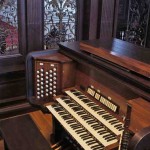 Skinner Organ Co., Opus 793, 1930
Skinner Organ Co., Opus 793, 1930
Church of the Covenant
“We have one steeple in Boston that to my eyes seems absolutely perfect,” wrote Oliver Wendell Holmes of Church of the Covenant’s spire. Built between 1865 and 1867 as Central Congregational Church by architect Richard M. Upjohn (son of the Upjohn of Trinity Wall Street fame), the church merged with First Presbyterian Church in 1931. Louis Comfort Tiffany carried out an extensive remodeling of the sanctuary in 1894, incorporating an immense lantern exhibited at Chicago’s Columbian Exposition of 1893, its seven angels of the Apocalypse clasping orbs illuminated by the new technology of electricity. Forty-two windows demonstrate Tiffany’s mastery of the painterly effects made possible by opalescent glass. Islamic-inspired mosaics and motifs add to the overall impression of gloomy splendor.
Welte pipe organs are a rare species, the name being more associated with self-playing pianos and orchestrions. American-built Welte organs come from the short period 1925 to 1931, manufactured by firms unaffiliated with the original German firm. Boston’s Welte is distinguished by the involvement of Richard Whitelegg, a Willis-trained voicer who emigrated in 1925 and was associated with M.P. Möller from 1931 until his death, in 1944. Placed in two widely separated chambers, Great and Choir are on the right, Swell and Solo on the left, with Pedal voices in each chamber. Charles Courboin, organist at Wanamaker’s in Philadelphia and tonal adviser to Welte, dedicated this instrument in 1929.
The organ underwent various tonal changes typical of the 1960s, coming to fresh notice in the 1970s, when Nelson Barden linked up a Welte player to recreate historic roll performances. In 2000, Austin Organs, Inc. rebuilt the organ with Spencer Organ Company as principal subcontractor. While not a restoration, the project was undertaken in a sympathetic manner that preserved all existing Welte material, including Boston’s only diaphone.
Austin Organs, Inc. – 2000, rebuilding
Christ Church, Cambridge
Established in 1759 by Cantabrigians weary of the long trek to King’s Chapel by carriage and ferry, Christ Church is also the work of noted colonial architect Peter Harrison. Loyal to the Crown, the church’s closure became inevitable by 1774. Martha Washington did her best, organizing a service at which prayers for the King’s enlightenment were offered, but a destructive riot during a re-opening for a single funeral in 1778 proved decisive. Not until 1829 did finances recover sufficiently to hire a rector. Lengthened by two bays, in 1857, and tricked out in Victorian garb, its Georgian sensibilities were restored by 1920, in time for E. Power Biggs’ arrival in 1932. An award-winning restoration began in 2011.
Since 1879, when Sunday school teacher Theodore Roosevelt was dismissed because he was not Episcopalian, Christ Church has evolved into a well-known center for ecumenism and social activism. It hosted Martin Luther King, Jr. and Benjamin Spock for a press conference to denounce the Vietnam War when neighboring Harvard University declined.
Like many Churches of England in the Colonial era, Christ Church started out with organs from England. The 1762 Snetzler met a quick fate when its pipes were melted down to make Revolutionary bullets. Not until 1845 did a new organ arrive, from George Stevens, though soon replaced in 1860 by a larger one from William B.D. Simmons. In 1877, this instrument was moved into a chamber at the front of the church, where it was found lacking, as was its 1883 successor from Hook & Hastings. In early 1941, Aeolian-Skinner completed a forty-eight-rank, three-manual organ in a new chamber; its four-manual console anticipated a never-built eighteen-rank, two-manual gallery section. The strong ideas of consultant Ernest White (of the Church of Saint Mary the Virgin in New York, and later tonal director of M.P. Möller) were in evidence, from the paucity of wooden pipes, profusion of tapered registers, and twenty ranks of upperwork. But this light-toned, driven organ was no match for its thin-walled unhelpful chamber; not even an artificial reverberation system of 1959 helped.
The 2006 Schoenstein is the first pipe organ in this forbidding acoustic to put practicality and principle on an even footing. The organ’s high pressures and undaunted volume transcend a chamber now rebuilt with more density and mass. Near total enclosure (seven registers doubly so) and neo-orchestral ideals offer the player a broad palette of color. The console, initially located on the right, near the case, was moved to a central pit in 2013.
The rear-gallery organ, on long-term loan from Harvard University, was built in London by William Gray in 1805, and restored in 1998 by Wissinger Organs.
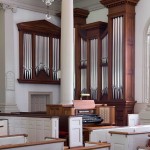 Schoenstein & Co., Organ Builders, Opus 149, 2006
Schoenstein & Co., Organ Builders, Opus 149, 2006


